
भारतीय कृषि अनुसंधान परिषद
Indian Council of Agricultural Research
भा.कृ.अनु.प. – राष्ट्रीय शूकर अनुसंधान केन्द्र
ICAR - National Research Centre on Pig
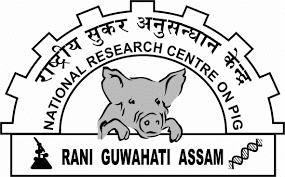

भारतीय कृषि अनुसंधान परिषद
Indian Council of Agricultural Research
भा.कृ.अनु.प. – राष्ट्रीय शूकर अनुसंधान केन्द्र
ICAR - National Research Centre on Pig

India possesses a rich genetic diversity in its livestock, including a varied population of pigs. As of May 2024, fourteen indigenous pig breeds have been identified and officially recognized, with ongoing efforts to characterize the substantial population of nondescript pigs. The Indian pig population consists of 29.40% descript pigs, comprising 2.80% exotic, 18.10% crossbred, and 8.20% indigenous pigs, while 70.60% are non-descript pigs which are yet to be categorized for their breed status. The major population of indigenous pigs is contributed by nondescript pigs which need to be characterized. Apart from the nondescript pigs, there are 14 distinct pig breeds which have been registered as breed in the national database. These indigenous pigs of India are identified as a distinct group due to gradual domestication of wild pigs. These pigs differ in their characteristics from region to region depending on the climatic conditions and topography.
Ghoongroo is the first recognized pig breed of India, registered in the national database with accession number INDIA_PIG_2100_GHOONGROO_09001. This indigenous breed originates from the Eastern Sub-Himalayan region of West Bengal, particularly North Bengal. It is favoured by local communities for its high prolificacy and ability to thrive in low-input systems. These pigs are predominantly black, occasionally displaying white hooves and metapodials. They are characterized by a broad, flattened face and a short, upwardly curved snout. Their large, pendulous, heart-shaped ears resemble elephant ears, making them easily identifiable. Ghoongroo pigs have a distinctive bulldog-like facial appearance. The litter size ranges from 8 to 18 piglets, with an average of 8.84±0.40 at birth and 7.56±0.39 at weaning. Newborn piglets typically weigh around 1.0 kg, and at weaning, they weigh between 7.0 and 10.0 kg. Some selected sows have produced litters of up to 17 piglets at birth. Sows have seven pairs of teats. Adult Ghoongroo pigs weigh between 80 and 100 kg. The pre-weaning growth rate is 183.357 ± 29.76 gm/day, while the post-weaning growth rate is 265.92 ± 25.45 gm/day. At eight months, the average body weight is 62.35 ± 3.33 kg for males and 58.50 ± 3.42 kg for females. Both sexes are docile and easy to handle, with females exhibiting excellent fecundity and mothering ability, crucial for piglet survivability.

These pigs found mostly in the Khasi, Garo and Jayantia mountain of Meghalaya state. The colour of this pig is generally black but star shaped white at forehead and hock joint may present. The Snout is medium tapering partially white at nostril, Bristle is long on midline and uniformly at other places Niang Megha is the second registered pig breed in the national database, with accession number INDIA_PIG_1300_NIANGMEGHA_ 09002. This small-sized indigenous breed reaches a body weight of 35-40 kg by ten months of age. The pre-weaning growth rate is 84.45 ± 1.21 gm/day, while the post-weaning growth rate is 133.55 ± 1.91 gm/day. The average litter size at birth is 5.80 ± 0.42, and at weaning, it is 4.57 ± 0.48. Newborn piglets weigh about 0.54 ± 0.34 kg, and by weaning, they weigh approximately 5.25 ± 0.44 kg.

Agonda goan is the third recognized breed of pig in India with accession no. INDIA_PIG_3500_AGONDAGOAN_09003. This breed is found in the Tiswadi, Bardez, and Pernem regions of the North Goa district, as well as the Mormugao, Canacona, and Quepem talukas of the South Goa district. The animals are small, featuring short ears, a short snout, a pot belly, and a wild nature with rough bristles. While the predominant colour is black, some animals exhibit white patches on their legs and face. They are known for being very furious and alert. The large-sized Agonda Goan pig is preferred by locals for its meat, especially during marriages and other festivals. The average adult body weight at 12 months is 46.90±3.70 kg, with males averaging 46.58±4.50 kg and females averaging 47.27±6.46 kg. The average litter size is 7.21±0.41 at birth and 5.93±0.28 at weaning. The pre-weaning growth rate is 79.25±9.86 g/day, while the post-weaning growth rate is 153.85±13.34 g/day. Newborn piglets weigh approximately 0.534±0.012 kg, and by weaning, they weigh around 3.53±0.094 kg.
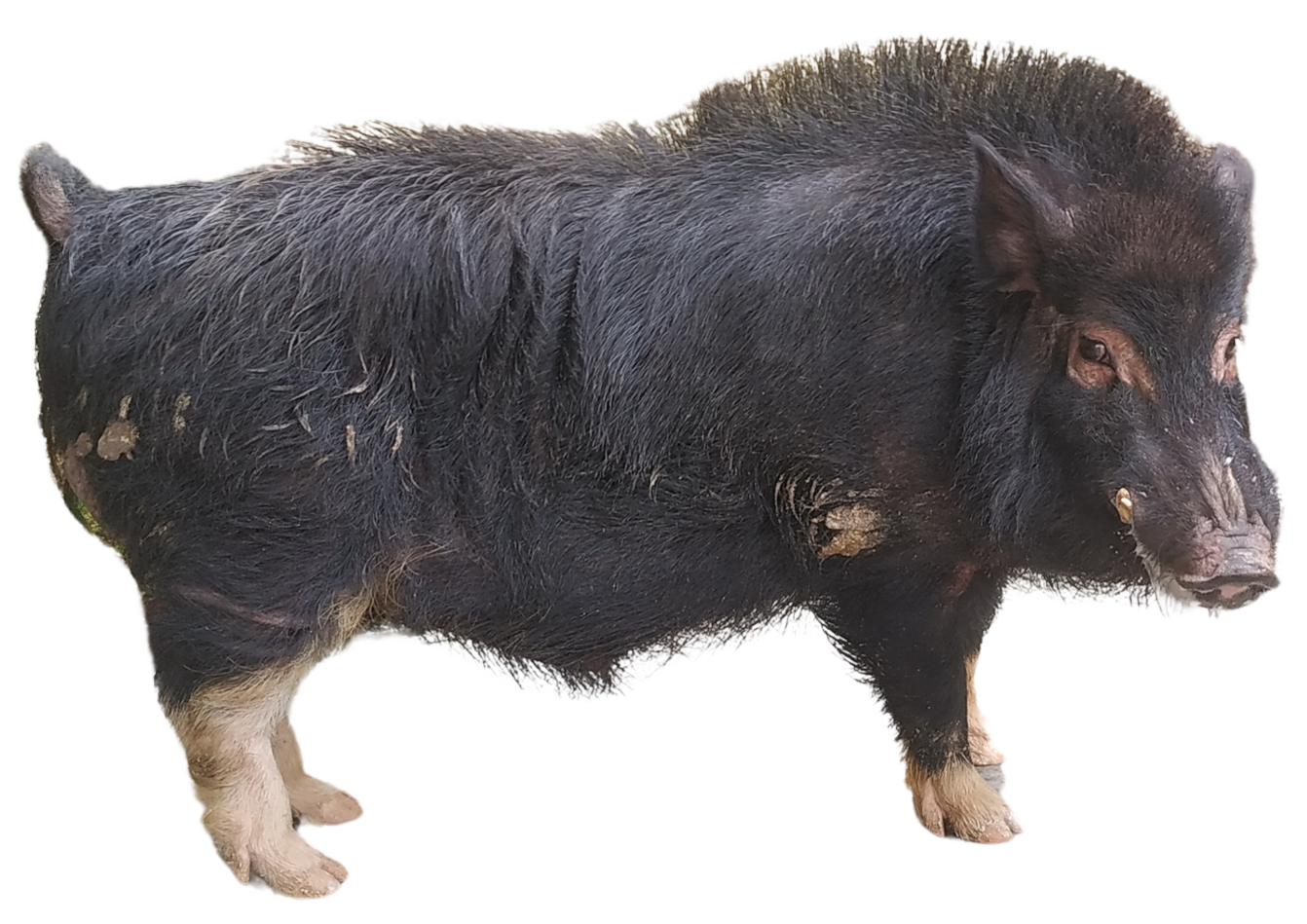
The Tenyi Vo pig, also known as Votho, Naga Local, or Suho, has breeding tract primarily in the Kohima, Phek, and Dimapur districts of Nagaland. This breed is named after the Tenyimia communities, including Angami, Rengma, Chakesang, and Zealiang, who are responsible for its breeding. The Tenyi Vo pig is raised mainly for pork production in Nagaland. These pigs are characterized by a long, strong, tapering snout, small erect ears, and bright, alert eyes. Adult pigs typically weigh between 36 kg and 50 kg, with an average adult body weight of 40 kg. At 10 months old, their average weight is recorded as 24.57±0.31 kg. The Tenyi Vo pig is mostly black in color, with both sexes exhibiting this trait. They have a pot-bellied appearance, with females having a sagging back and pendulous belly that touches the ground. Other distinctive features include a straight tail ending with a white switch reaching the hock joint, white stockings, and white markings on the forehead and ventral body. This breed is registered in the national database with the accession number INDIA_PIG_1400_ TENYIVO_09004. At birth, the average individual weight is 0.62±0.35 kg, and at weaning, it is 2.80±0.48 kg. The average litter size at birth is 5.87±0.48, and at weaning, it is 5.37±0.47. The litter weight at birth is 2.67±0.67 kg, and at weaning, it is 22.57±1.08 kg.
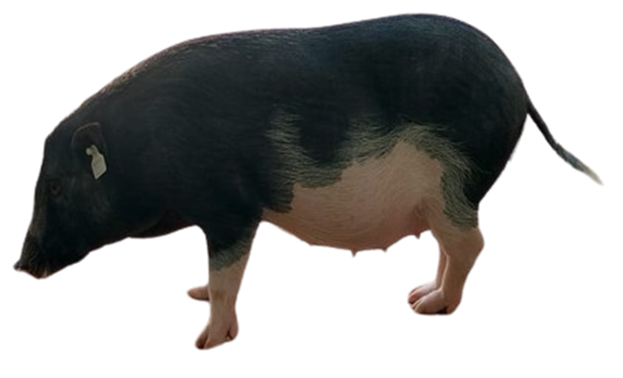
The Nicobari pig, indigenous to the Nicobar Islands, has been reared by the Nicobari tribes since ancient times. Found primarily in the Nicobar District of the Andaman & Nicobar Islands, this breed is also known as Ha-un or Naut, meaning "pig" in the local Nicobari language. Rearing Nicobari pigs is a symbol of pride and an asset for families, and these pigs play a significant role in the socio-cultural activities and ceremonies of the Nicobari tribes. It is adapted to the natural environment of the Nicobar Islands, which includes rainforests, mountain forests, and plantation areas. Nicobari pigs are mostly black and brown, with some pigs exhibiting creamy-white, reddish-brown, or mixed black and brown colours. They have a sturdy, short, and long body, with a medium to short snout and short erect ears. A marked bristle crest (mane) extends from mid-head/shoulder to the base of the tail. Their facial profile ranges from flat to concave, and they have a short neck with a very large jowl. The tail is notable for its lack of curling. Nicobari pigs are ferocious in nature and have an average adult body weight of 63 kg. This breed is registered in the national database with accession number INDIA_PIG_3300_NICOBARI_09005. The average litter size at birth is 6.45 ± 0.28, and at weaning, it is 6.17 ± 0.53. The average litter weight at birth is 10.42 ± 0.67 kg, and at weaning, it is 42.71 ± 1.82 kg. The average individual weight of piglets at birth is 1.59 ± 0.05 kg, and at weaning, it is 6.46 ± 0.20 kg. The pre-weaning growth rate is 0.31 ± 0.007 Kg/day, while the post-weaning growth rate is 0.34 ± 0.009 Kg/day. At eight months, the average body weight is 70.16±1.31 kg for males and 61.56±1.13 kg for females.
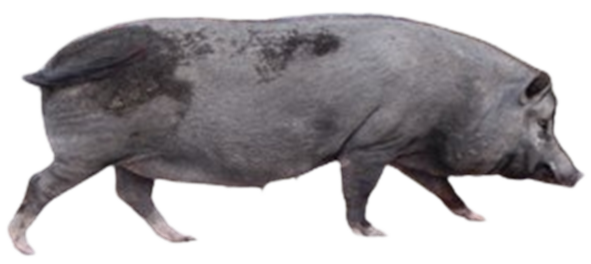
The Doom pig, indigenous to Assam, is named after the local 'Doom' community, which has been rearing these pigs for generations. Found in the Dhubri, Bongaigaon, and Kokrajhar districts of Assam, Doom pigs are black in colour and have a short, concave snout. The meat of Doom pigs is lean and highly palatable, fetching a higher price in the market. These pigs are adapted to a migratory scavenging system, requiring minimal inputs. Farmers often move their pigs from place to place in search of food, and some provide housing using low-cost, locally available materials. Doom pigs have a large, flat-bellied body type, short erect ears, and a straight topline with long bristles extending to the thoraco-lumbar area. This breed is registered in the national database with the accession number INDIA_PIG_0200_ DOOM_09006. The averages litter size at birth and weaning was 6.250 ± 0.237 and 5.025 ± 0.210, respectively. The average litter weight at birth and weaning was 3.475 ± 0.114 and 30.289 ± 1.184 kg respectively. The average adult weight at 12 months was 64.37 ± 3.26 kg while at 8 months was 41.28 ± 2.83 kg. The pre-weaning growth rate is 57.14 ± 4.03 g/day And post-weaning growth rate is 193.08 ± 17.22 g/day.
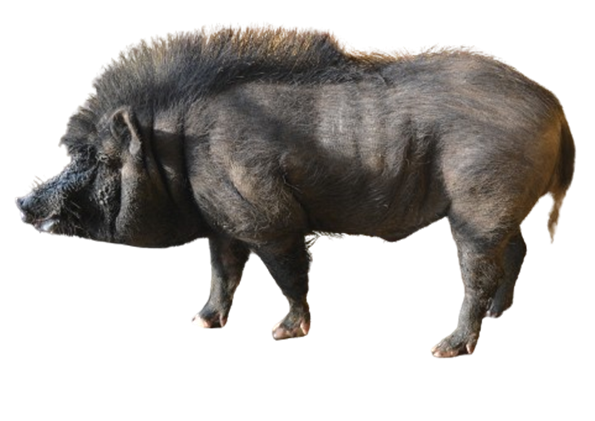
The Zovawk pig, also known as Mizo local, has breeding tract in the Aizawl, Lunglei, Lawngtlai, Champhai, Saiha, and Kolasib districts of Mizoram. The meat from this pig is highly preferred by locals. The name 'Zovawk' comes from the Mizo language, where 'Zo' means Mizo and 'vawk' means pig. This breed is well adapted to hilly regions. Zovawk pigs are predominantly black with a white spot on the forehead (star) and occasionally have white patches on the belly and white boots. They have distinctive erect ears, a concave snout, a pot belly, a concave top line, and long bristles along the mid-line. The average body weight is 32.27±0.87 kg at 8 month of age while adult weighs 50 Kg. Zovawk pigs are social animals, rarely staying alone under normal conditions. Historically, they foraged for food in groups and slept together, usually scavenging in and around houses and forest areas, and sleeping under houses in a head-to-tail arrangement. These pigs communicate through specific grunting sounds to indicate food, warn of danger, or call their young ones. In the face of danger, the leader emits a loud grunt, causing the group to huddle together in a circle with their snouts outward and the weaker and younger pigs in the centre. This breed is registered in the national database with accession number INDIA_PIG_2700_ZOVAWK_09007. The average litter size at birth is 5.67 ± 0.56, and at weaning, it is 5.67 ± 0.68. The average individual weight at birth is 0.47 ± 0.06 kg, and at weaning, it is 3.69 ± 0.09 kg. The pre-weaning mortality rate and adult mortality rate are both nil, while the post-weaning mortality rate is 3.89%. The pre-weaning growth rate is 73.90 ± 0.47 g/day, and the post-weaning growth rate is 159.78 ± 1.50 g/day.
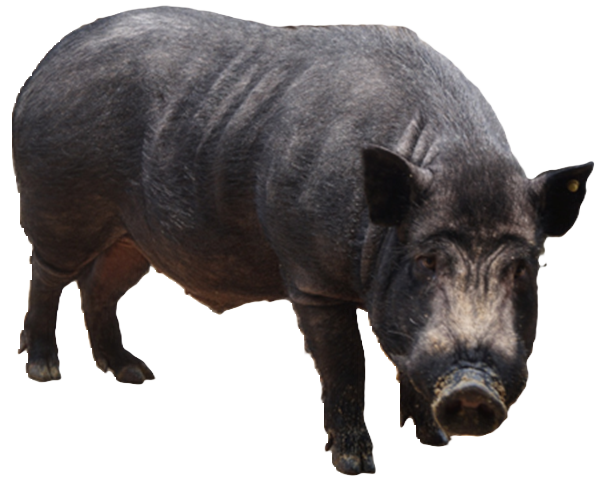
These pigs are native to the Bareilly division and adjoining parts of the Lucknow division in Uttar Pradesh. Also known as Deshi or Bareilly Local, they produce a peculiar sound called "Ghur," which is why they are named Ghurrah. These pigs are primarily black, though some are greyish-black or brownish. They are medium-sized with flat bellies, angular bodies, and long straight snouts. Their legs below the hock joint are white, and a thick line of hair runs from the neck to the shoulders. They have elongated heads with triangular faces and short, leaf-shaped, vertically erected ears. Adult male Ghurrah pigs weigh about 46 kg, while females weigh about 48 kg. The farmers prefer Ghurrah pigs for their disease resistance, hardiness, and adaptability to local conditions. These pigs can withstand dog attacks and protect their piglets without harm. This breed is registered in the national database with accession number INDIA_PIG_2000_GHURRAH_09008. The individual piglet weight at birth is 0.85 ± 0.03 kg, and the litter weight at birth is 5.83 ± 0.18 kg. The litter size at birth is 6.85 ± 0.16, and at weaning, it is 5.65 ± 0.21.

The Mali pig is native to the Dhalai and North districts of Tripura. These pigs are generally black with star-shaped white patches on their foreheads. They are medium-sized with pot bellies and medium to small bristles distributed throughout their bodies. Recently, the Mali pig has been registered as a breed by the NBAGR with accession number INDIA_PIG_1900_MALI_09009. Mali pigs are characterized by their short, erect ears lying perpendicular to the body axis and a concave snout. The average mature body weight is 64.14 ± 2.25 kg. The average litter size at birth is 5.71 ± 0.24, and at weaning, it is 4.46 (ranging from 3 to 6). Specifically, the average litter size at birth is 6.6 ± 0.4 and at weaning is 5.5 ± 0.3. The individual body weights of piglets at birth and weaning are 0.465 ± 0.016 kg and 4.0 ± 0.1 kg, respectively. At five months, the body weight of Mali pigs is 27.4 ± 0.3 kg, and at one year, it is 73.4 ± 0.7 kg. The average age at first farrowing is 281.4 ± 1.6 days. Sows typically come into heat soon after weaning. Mali pigs are usually sold at the age of about 1 to 1.5 years, with a market weight of about 70 kg.

Purnea is the first registered pig breed from Bihar and Jharkhand, with the accession number INDIA_PIG_0325_PURNEA_09010. This black-coloured, medium-sized pig is primarily found in the Purnea and Katihar districts of Bihar and the adjoining areas of the Sahibganj district in Jharkhand. Purnea pigs have compact bodies and pot bellies, with some individuals displaying white spots on their lower limbs. A thick line of bristles runs along the top line from the neck to the shoulders, giving the pigs a wild appearance. These pigs are characterized by round faces, short conical and erect ears, and small, thick, slightly concave snouts. Their skin is thick, with neck folds in mature animals, and they have a ferocious nature. The average adult body weight at 12 months is 45.05 ± 2.55 kg, with males averaging 46.83 ± 2.81 kg and females averaging 44.11 ± 3.55 kg. The average litter size is 5.02 ± 0.18 at birth and 4.97 ± 0.17 at weaning. The pre-weaning growth rate is 89.29 g/day, and the post-weaning growth rate is 139.33 g/day. Newborn piglets weigh approximately 0.72 ± 0.04 kg, and by weaning, they weigh around 5.07 ± 0.25 kg.

The breeding track of Banda pig is Jharkhand. These pigs are black coloured, having short and erect ear. These pigs have a long and concave snout, medium to short bristle on neck. The average adult body weight is 28.0 kg in male and 27.0 kg in females and litter size ranges from 4 to 7. Banda is small sized pig, with typical ‘wild look’ and highly ferocious. Coat colour is mainly black or dark grey. Distinguishing features included body covered with thick hair, specially on poll and neck, small but elongated snout, small erect ears. Also having specific burrowing nature. These physical conformation traits are true breed characters and do not match with any of the recognised indigenous pig breed. The pork is leaner and tastier and highly preferred for its taste by local people.

The breeding tract of the Manipuri Black pig is in the state of Manipur. These medium-sized pigs are predominantly black, although grayish-black body coats and white patches on the extremities can also be seen. They have a medium-sized, concave, dish-shaped head, a short slightly upward-curved snout, a well-built long body with short legs, and a prominent neck. Both males and females are covered with short hair. The average adult body weight is approximately 96.0 kg for males and 93.0 kg for females. At 10 months, the average body weight is about 80 kg. The average litter size at birth is between 8 and 10 piglets, and at weaning, it ranges from 6 to 9 piglets.

The breeding tract for this pig spans the various districts of the Garo Hills division, including North, East, South, West, and South West Garo Hills of Meghalaya. Wak Chambil pig is one of the unique and well adapted indigenous pig reared under low input backyard production system in the eastern Himalayan hill ecosystem. These pigs are small, predominantly black and white in colour, and possess well-built, compact body structures with short limbs. They have small heads, small eyes, medium snouts, small erect ears, and small hooves that touch the ground less frequently. Their pendulous bellies further distinguish them from other pig breeds. At 10 months, the average body weight of an adult Wak Chambil pig is 34.63±2.02 kg. The average litter size at birth is 5.5±0.73, and at weaning, it is 4.5±0.91. These pigs have a smaller body size, an adequate growth rate, and lower litter performance compared to other indigenous pigs of the northeastern region.
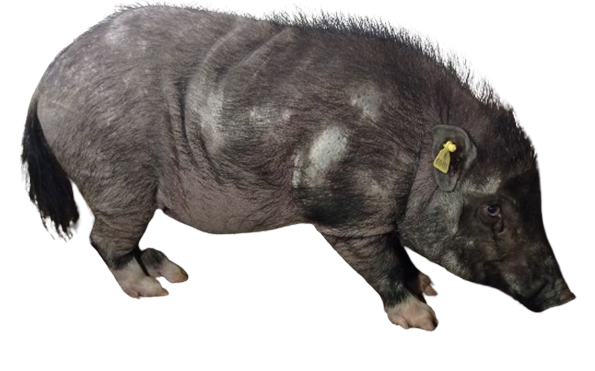
This pig is distributed across various islands in the Andaman group of islands. They are sturdy, medium-sized pigs that are black or brownish in colour. They have short to medium snouts and short, upward-erected ears. The most commonly observed feature is a slight downward arch or curvature of the back. The litter size at birth is 7.07 ± 0.14, and at weaning, it is 6.44 ± 0.12. The average individual weight of piglets at birth is 1.52 ± 0.02 kg, and at weaning, it is 10.03 ± 0.08 kg. At 8 months of age, the adult body weight is 77.96 ± 0.18 kg. Males tend to have higher body weights from 1 to 9 months of age compared to females. Similarly, significantly higher reproductive parameters are observed in males than in females.
